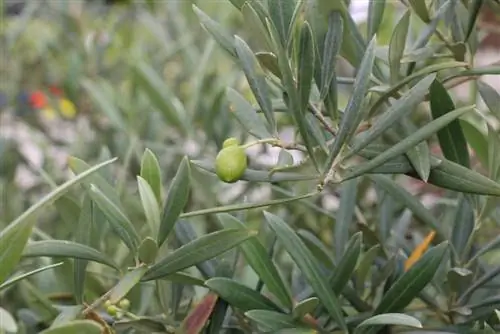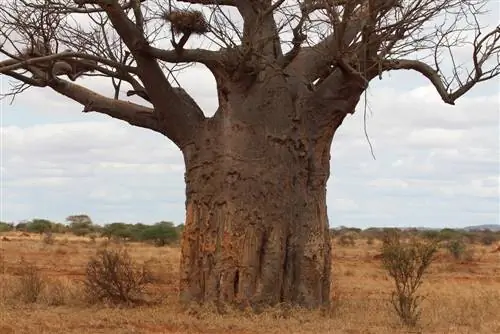- Author admin [email protected].
- Public 2023-12-17 03:39.
- Last modified 2025-01-24 12:45.
The majestic ginkgo, which was named the 'Tree of the Millennium', comes from the green treasury of Asia. So that indoor gardeners don't have to do without this impressive relic of early earth history, there is the fan leaf tree Ginkgo biloba 'Troll'. The successful variety remains at an ideal height of 60 to 100 centimeters and has modest demands. Find out here how caring for the ginkgo as a houseplant becomes a successful gardening project.
Care instructions
The ginkgo tree has survived ice ages and dinosaurs during its evolution. Equipped with a we alth of experience that goes back millions of years, the living fossil cannot throw anything off track so quickly. This makes a fan leaf tree the ideal houseplant for beginners. The short-statured variety 'Troll' is also characterized by a pronounced location tolerance, coupled with excellent regenerative ability and striking resistance to diseases. To ensure that the magical tree shows its most beautiful side, the following care instructions highlight all the important criteria relating to keeping it as a houseplant.
Location
The mobility as a potted plant allows the Biloba 'Troll' to always be offered ideal conditions. Although older trees prefer a sunny location, young plants prefer a semi-shady location. The legendary world tree is happy to take note when it is granted a place on the sunny balcony from spring to autumn.
Substrate
In any good planting soil, a 'troll' likes to stretch out its roots. Due to its slow growth rate, the tree remains in the pot for several years. It is therefore advisable to use structurally stable and high-quality potted plant soil as a substrate. The soil should be rich in nutrients and well-drained. If you have your own garden, mix in a handful of clay soil, which the fan leaf tree is very comfortable with. Inorganic additives, such as lava granules, coconut flakes or expanded clay, prevent premature compaction and resulting waterlogging.
Bucket
The perfect pot for a ginkgo as a houseplant is tailored to the root ball. There should be two to three finger widths of space between the ball and the edge of the pot. A bottom opening allows excess irrigation water to drain away unhindered. Waterlogging is one of the few care problems that can bring down a Biloba 'Troll'. Please fill a saucer with expanded clay balls or pebbles so that accumulated water does not rise again into the substrate.
Tip:
If you have a choice when purchasing, it is best to choose a male plant that has been propagated from cuttings. Female specimens exude an unpleasant smell of butyric acid, which thoroughly spoils the joy of the magical fan leaf tree in living rooms.
Watering and fertilizing
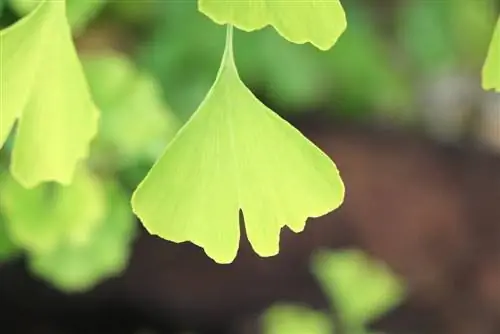
As a container plant, a ginkgo tree prefers slightly moist substrate. Only water when a finger test indicates that you actually need water. Insert your thumb or index finger one to two centimeters deep into the soil. If you feel moisture, delay your water intake for a few days. This is how you water and fertilize a fan leaf tree in an exemplary manner:
- If the soil is noticeably dry, water with room temperature water
- Let the water run onto the root disk until the saucer fills up
- From March to October, add a liquid green plant fertilizer to the irrigation water every 2 to 3 weeks
Cutting
Thanks to a good-natured pruning tolerance, a variety of crown training options are possible. It is up to your horticultural judgment as to whether a Biloba 'Troll' shines with a light-flooded or densely bushy crown. Both forms have their individual advantages. With a thin crown, you will never complain about the center of the crown becoming bald because sunlight can penetrate into all regions. A densely branched crown boasts a breathtaking color spectacle in autumn. Whatever form of cultivation you prefer, the following cutting instructions apply to all indoor varieties:
- The best time is in spring when there are no leaves
- Previously thin out damaged, broken and dead branches at the base
- Only cut back the leading branches of the crown if there is not enough space
- Prune annual side branches by a third for lush branching
- Make the cut just above an outward-facing bud
- Cut off shoots sprouting from the trunk below the crown vertically just before the bark
The expert tree nursery has already set the course for the crown structure with a balanced structure of leading branches. Only cut back a scaffold branch when it is actually necessary and the crown as a whole has become too sprawling. Every cut back on the slowly growing framework runs the risk of mutilating a previously harmonious crown. Such concerns do not apply to side branches. By shortening one-year-old side shoots, you cause sap to accumulate below the cut point. As a result, previously dormant buds sprout, so that the crown branches more luxuriantly. Cutting into old wood is not recommended. If you find yourself forced to remove a dead branch, place the scissors or saw just in front of the branch ring, visible as a bulge in the transition between the branch and the trunk.
Tip:
For pruning care, we recommend garden or pruning shears with a bypass mechanism. In this version, two sharp blades cut the branch. This has the advantage that smooth cuts are created that heal quickly. Anvil scissors work with one sharp and one blunt side, so there is a risk of bruising the bark.
Wintering
After the autumn leaves fall, your 'troll' should move to its winter quarters. Ideally, the ornamental tree spends the months of November to February in an unheated room at temperatures of around 5 degrees Celsius. Without its pretty leaves, the tree is not dependent on light, so a dark basement room is a possible option. Please do not place a fan leaf tree in a pot outside. In contrast to planted specimens, the root ball in the pot is not completely frost-resistant. How to properly care for a ginkgo tree in winter:
- Water sparingly so that the substrate does not dry out
- Do not fertilize from the beginning of November to the beginning of March
- Check regularly for pest infestation
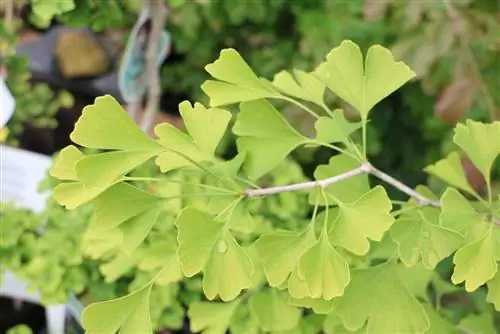
At the end of February, the plant returns to its original position in a sunny to partially shaded location in the living room, office or winter garden. First, continue watering sparingly. Only when the first leaves sprout do you gradually increase the water supply and resume the nutrient supply.
Repotting
The care program includes changing to fresh substrate at intervals of two to three years. Given the slow pace of growth, the existing pot can usually be reused. Only when roots push through the soil or grow out of the opening in the ground does the fan leaf tree want a larger pot. The rule of thumb is: As long as there is two finger-widths of space between the root ball and the wall of the pot, the previous container can be used again. How to properly repot a ginkgo tree as a potted plant:
- The best time is in early spring, before the first leaves sprout
- Remove the root ball from the edge of the pot with a long knife
- Grip the trunk at the bottom and pull it out of the bucket
- Shake off the leached soil, remove thicker chunks with your fingers
- Cut off diseased, dead and stunted roots
Clean the bucket thoroughly with hot water. Then spread a five to eight centimeter high drainage made of potsherds or expanded clay on the bottom of the pot, covered with an air and water permeable fleece to protect against siltation. Fill the bucket one third full with fresh substrate. Position the plant in the middle of it. In this phase of repotting, a good sense of proportion is important because the previous planting depth should be maintained as precisely as possible. While you stabilize the trunk with one hand, add soil in stages, pressing lightly so that no cavities form. Finally, water the repotted 'Troll'. In a partially shaded location, the tree can regenerate from the stressful procedure for two to three weeks.
Diseases and pests
Over the course of millions of years of their evolution, ginkgos have acquired a robust resistance to plant diseases and pests of all kinds. The only Achilles heel in the care program is waterlogging. Anyone who expects their cheerful ancient tree to have a constantly wet substrate will be faced with a total failure.
More beautiful varieties
The choice for a fan leaf tree as a houseplant is not limited to the popular graft 'Troll'. The following varieties also appeal to the indoor gardener:
Mariken
This variety is well on its way to overtaking its fellow 'Troll' as the most popular indoor ginko. Grafted on a sturdy trunk, 'Mariken' boasts a spherical crown made of picturesquely shaped leaves. The delicate cultivated form grows very slowly and spreads pastoral calm in living rooms and offices.
- Growth height: 100 to 150 cm
- Growth width: 100 to 150 cm
Obelisk
The new variety impresses with its slender, columnar shape and elegantly fanned decorative leaves. In contrast to most other varieties, 'Obelisk' sets a comparatively rapid pace of 10 to 40 centimeters per year. What is outstanding is the flexibility with which the fan leaf tree adapts to local space capacities.
- Growth height: 200 to 600 cm
- Growth width: 100 to 300 cm
Barabite Nana
This rarity among the dwarf ginkgo varieties is perfect for cultivation in a pot. The decorative leaves, which appear two-lobed due to a central incision, are a feast for the eyes. As is characteristic of many varieties, the decorative foliage sprouts in dense clumps. In September, golden yellow autumn colors herald the season finale indoors and outdoors.
- Growth height: 150 to 200 cm
- Growth width: 150 to 200 cm
Interesting facts
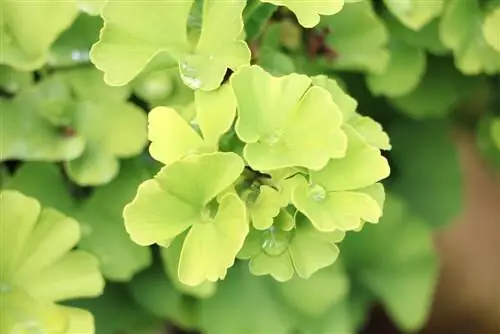
With the ginkgo tree, a green wanderer through time finds its way into your home. Scientists assume that the tree species has colonized the earth for more than 300 million years. The ancestors of the indoor mini version Ginkgo biloba 'Troll' thrived with needle- to tongue-shaped leaves. In the course of evolution, today's decorative fan leaves were formed. The unique phenomenon is one of the distinctive characteristics of the millennium tree, spectacularly enhanced by a colorful, golden-yellow autumn color before the winter leaves fall. Her splendid foliage sets the scene for the primitive icon with her pyramidal stature and expansive crown.
Big tree very small
While the ancestor reaches a majestic height of 40 meters, the premium variety 'Troll' remains at a height of 60 to 80 centimeters. The breeding genius is achieved through head refinement. To do this, the knowledgeable master gardener combines a stable trunk with an elegant crown. Since the trunk does not grow any further in height as a base, the fan leaf tree only gains width. Given its annual growth rate of a leisurely 2 to 3 centimeters, the indoor version of the ginkgo will not cause you any space problems.


